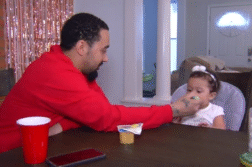MIAMI, Fla. (Ivanhoe Newswire) — Low testosterone affects more than ten percent of men worldwide. The condition can cause fatigue, low libido and even depression. Now, a nasal treatment is helping men feel better and keep their dreams of starting a family alive.
Robert knew something wasn’t right after feeling sluggish for almost two years.
“Not really having the energy or the desire to work out or just work through the entire day,” Robert said.
A blood test revealed he had low testosterone, a common condition on the rise in younger men.
Ranjith Ramasamy, MD, Director of Reproductive Urology at the University of Miami Health System said, “At least one in three men between the ages of 32 to 50 appear to have low testosterone.”
Dr. Ramasamy says factors such as stress, obesity and poor sleep habits may be to blame. Symptoms include: “low energy, fatigue, improper sleep, weight gain, erectile dysfunction or lack of libido,” Dr. Ramasamy explained.
He says testosterone therapies like injections and gels have one major side effect.
“All of these treatments will actually block hormones from the pituitary gland,” Dr. Ramasamy stated.
Now a treatment called Natesto, applied through the nose, is offering younger patients another option.
“Because this is used two to three times a day and it’s short acting, it still preserves your hormones from the pituitary gland and therefore maintains your sperm production,” Dr. Ramasamy told Ivanhoe.
He says so far, patients enrolled in the University of Miami study have preserved their fertility and feel great!
Dr. Ramasamy said, “They are able to lose weight, get back to the gym, obviously their sex life has improved.”
Robert says taking Natesto has made a big difference.
“I have the energy, I have the desire to be active and to do things,” Robert shared.
Feeling more like himself again.
Natesto was FDA approved in 2012 but is being studied as a treatment option for men who want to preserve their fertility. Side effects of testosterone therapy include the risk of blood clots and breast enlargement. So always talk to your doctor first. Natesto is covered by most insurance companies, otherwise it costs about 200 dollars a month. For more information on the treatment or the clinical trial go to www.clinicaltrial.gov and type in Natesto.
Contributors to this news report include: Janna Ross, Field Producer; Judy Reich, Videographer; Cyndy McGrath, Supervising Producer; Roque Correa, Editor.
To receive a free weekly e-mail on Medical Breakthroughs from Ivanhoe, sign up at: http://www.ivanhoe.com/ftk
MEDICAL BREAKTHROUGHS
RESEARCH SUMMARY
TOPIC: NASAL TESTOSTERONE PRESERVES FERTILITY
REPORT: MB #4590
BACKGROUND: Testosterone is the male sex hormone that is made in the testicles. Testosterone hormone levels are important to normal male sexual development and functions. Some men have low testosterone levels. This is called Testosterone Deficiency Syndrome (TD) or Low Testosterone (Low-T). Deficiency means that the body does not have enough of a needed substance. The syndrome is a group of symptoms that, together, suggest a disease or health condition. The American Urology Association identifies low blood testosterone (Low-T) as less than 300 nanograms per deciliter. Some symptoms or conditions that may accompany Low-T are low sex drive, fatigue, reduced lean muscle mass, irritability, erectile dysfunction, and depression.
(Source: https://www.urologyhealth.org/urologic-conditions/low-testosterone)
SIDE EFFECTS: Millions of American men use a prescription testosterone gel or injection to restore normal levels of the manly hormone. The ongoing pharmaceutical marketing blitz promises that treating “low T” this way can make men feel more alert, energetic, mentally sharp, and sexually functional. However, legitimate safety concerns linger. For example, some older men on testosterone could face higher cardiac risks. A relatively small number of men experience immediate side effects of testosterone supplementation, such as acne, disturbed breathing while sleeping, breast swelling or tenderness, or swelling in the ankles. Doctors also watch out for high red blood cell counts, which could increase the risk of clotting. Men on long-term testosterone appear to have a higher risk of cardiovascular problems, like heart attacks, strokes, and deaths from heart disease. Some physicians also have a lingering concern that testosterone therapy could stimulate the growth of prostate cancer cells. As with the hypothetical cardiac risks, the evidence is mixed. But because prostate cancer is so common, doctors tend to be leery of prescribing testosterone to men who may be at risk.
NEW TREATMENT: Ranjith Ramasamy, MD, Director Of Reproductive Urology at the University of Miami Health System talked about the new treatment option Natesto, “Just like many other medications that we’ve put through the nose, like medications that are used for allergies, they go through the nose and are absorbed systemically. It’s the same concept. It’s absorbed through the blood supply from the nose and men who have been on the drugs so far have very good testosterone levels.”
(Source: Ranjith Ramasamy, MD)
FOR MORE INFORMATION ON THIS REPORT, PLEASE CONTACT:
Jose Boza, Public Relations
786-326-7988
If this story or any other Ivanhoe story has impacted your life or prompted you or someone you know to seek or change treatments, please let us know by contacting Marjorie Bekaert Thomas at mthomas@ivanhoe.com




